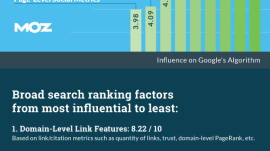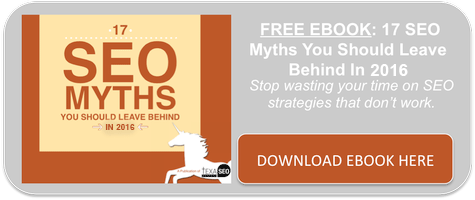Moz’s 2015 Search Engine Ranking Factors presents survey data from over 150 marketing professionals specializing in Search Engine Optimization. Their answers provide insight into the inner workings of the search marketing both now and in the future. The following data represents the opinions of our respondents of the various weighting of factors thought to be used (or not used) in Google’s search algorithm.
Google’s Broad Search Ranking Algorithm
Our respondents rated the relative levels of influence exerted by broad areas of ranking factors on a scale of 1 (not influential) to 10 (highly influential).
ValuesDomain-Level, Link Authority FeaturesPage-Level Link MetricsPage-Level Keyword & Content-Based MetricsPage-Level, Keyword-Agnostic FeaturesUser Usage & Traffic/Query DataDomain Level Brand MetricsDomain Level Keyword UsageDomain-Level, Keyword-Agnostic FeaturesPage-Level Social Metrics0123456789
Definitions:
Domain-Level, Keyword-Agnostic Features: Domain name length, TLD extension, SSL certificate, etc.
Domain-Level, Link Authority Features: Based on link/citation metrics such as quantity of links, trust, domain-level PageRank, etc.
Domain-Level Keyword Usage: Exact-match keyword domains, partial-keyword matches, etc.
Domain-Level Brand Metrics: Offline usage of brand/domain name, mentions of brand/domain in news/media/press, toolbar/browser data of usage about the site, entity association, etc.
Page-Level Social Metrics: Quantity/quality of tweeted links, Facebook shares, Google +1s, etc. to the page
Page-Level Link Metrics: PageRank, Trust metrics, quantity of linking root domains, links, anchor text distribution, quality/spamminess of linking sources, etc.
Page-Level Keyword & Content-Based Metrics: Content relevance scoring, on-page optimization of keyword usage, topic-modeling algorithm scores on content, content quantity/quality/relevance, etc.
User Usage & Traffic/Query: Data SERP engagement metrics, clickstream data, Visitor traffic/usage signals, quantity/diversity/CTR of queries, both on the domain and page level
Page-Level, Keyword-Agnostic Features: Content length, readability, Open Graph markup, uniqueness, load speed, structured data markup, HTTPS, etc.
Page-Level Keyword Usage Features
These features describe use of the keyword term/phrase in particular parts of the HTML code on the page (title element, H1s, alt attributes, etc).
Rated on a scale from 1 (no direct influence) to 10 (strong influence).
ValuesKeyword present in the title elementKeyword appears in the main content area ofthe pagePage contains close variants and/or synonymsof the keywordDegree of optimization for a topic modelingalgorithmKeyword present in the page’s URLKeyword present in the anchor text of an on-page linkKeyword present in the alt attribute of an imageon the pageKeyword present in specific HTML elements(bold/italic/li/a/etc)0123456789
Page-Level Keyword Agnostic Features
These elements describe non-keyword-usage, non-link-metrics features of individual pages (such as length of the page, load speed, etc.).
Rated on a scale from 1 (no direct influence) to 10 (strong influence).
ValuesUniqueness of the content on the pagePage is mobile friendly (for mobile rankings)Relative CTR from Google SERPs to the pagefor the keywordPage Load SpeedQuantity of searches for this keyword + specificbrand name, URL, or domain namePure bounce rate of the pageOverall design and/or user experienceDwell time or long click metricsFreshness of the content on the pageReturn visits to this page after initial query/clickLength of content on the pageThe age of the pageAverage browse rate after a click on this page inthe SERPsQuality of supplemental content on pagePage contains Schema.org or other structureddataReading level of the content on the pageUse of images on the pageUse of rich media (video, slides, etc.)Page supports HTTPS / SSLAuthor authority of pagePage is mobile-friendly (for desktop rankings)Page contains Open Graph data and/or Twittercards0123456789
Page-Level Link-Based Features
These features describe link metrics to the individual ranking page (such as number of links, PageRank, etc.)
Rated on a scale from 1 (no direct influence) to 10 (strong influence).
ValuesRaw quantity of links from high-authority sitesTopical relevance of linking pagesTopical relevance of linking domainsDiversity of link anchor text to the pageRaw quantity of links from knownbrands/entities to pageRaw quantity of unique linking domains to thepageTrust as measured by the distance from atrusted seed set of pages/sitesPosition/context of inbound linkPopularity of the page as measured byalgorithms like PageRank, etc.Link velocity of the pageRaw quantity of links that employ the keywordas partial-match anchor textRaw quantity of links that employ the keywordas the exact-match anchor textSentiment of the external links pointing to thepage0123456789Diversity of link anchor text to the page● Page-Level Link-Based Features: 6.94
Page-Level Social Metrics
These features relate to third-party metrics from social media sources (Facebook, Twitter, Google+, etc.) for the ranking page.
Rated on a scale from 1 (no direct influence) to 10 (strong influence).
ValuesEngagement with content/URL on socialnetworksRaw count of Google+ shares and +1sassociated with URLRaw count of Tweets associated with URLRaw count of Facebook likes and sharesassociated with URLComments about the page on social sitesSentiment of social links and citations referringto the pageRaw count of Pinterest pins associated withURLUpvotes for the page on social sites00.511.522.533.544.5
Domain-Level Keyword Usage Features
These features cover how keywords are used in the root or subdomain name, and how much impact this might have on search engine rankings.
Rated on a scale from 1 (no direct influence) to 10 (strong influence).
ValuesKeyword is the exact match root domain nameKeyword is present in root domain nameKeyword is closely related to domain namethrough entity associationKeyword is the subdomain nameKeyword is the domain extension01234567
Domain-Level Brand Metrics
These features describe elements that indicate qualities of branding and brand metrics.
Rated on a scale from 1 (no direct influence) to 10 (strong influence).
ValuesSearch volume for the brand/domainExistence/quality of verified real-world businessinfoQuantity of citations for the domain nameacross the webQuantity of co-occurrence keyword + brandacross webQuantity of mentions of the brand/domain onsocial sitesPopularity of business’s official social mediaprofiles01234567
Domain-Level Link-Authority Features
These features describe link metrics about the domain hosting the page.
Rated on a scale from 1 (no direct influence) to 10 (strong influence).
ValuesQuantity of unique linking domains to thedomainTopical relevance of linking domainsRaw popularity of the domain as measured byMozRank, PageRank, etc.Trust of the domain from as measured byTrustRank, MozTrust, etc.Distribution of linking domains’authorities/relative importance/popularityBacklinks from sites of your own geotargetedarea or languagePercentage of links with brand terms in theanchor textVelocity of link acquisition to the domainSentiment of the external links pointing to thesite012345678Sentiment of the external links pointing to the site● Domain-Level Link-Authority Features: 3.91
Domain-Level Keyword-Agnostic Features
These features relate to the entire root domain, but don’t directly describe link or keyword-based elements. Instead, they relate to things like the length of the domain name in characters.
Rated on a scale from 1 (no direct influence) to 10 (strong influence).
ValuesUniqueness of content across the whole siteUse of responsive design and/or mobile-optimizedAggregated CTR from Google SERPs for thedomainFreshness of content on the siteAggregated page load speed for pages ofdomainAggregated dwell time or long click metrics fordomainQuantity of error pages crawled on the siteAge of domainDomain is associated with high-authorityauthorsDomain contains trust signal pagesDomain lists contact informationQuality of other sites hosted on the same blockof IP addressesCharacter length of domain namePresence of hyphens used in domain nameLength of time until domain name expires012345678
Negative Ranking Factors
These responses relate to the relative negative impact of various features in Google’s ranking algorithm.
Rated on a scale from 1 (no direct influence) to 10 (strong influence).
ValuesTotal number of unnatural links topage/subdomainPage is duplicate contentPage content is thinAmount of over-optimized anchor text to pageNon-mobile friendly (for mobile SERPs)Keyword stuffing in documentPage links to spamPage has relative poor searcher satisfactionSlow page speedPage has relative poor engagement/usagemetricsTotal amount of advertising on pagePage links to high number of 404 pagesPage assets (CSS/JS) are blocked by robots.txtTotal number of times links from page and/orsubdomain have been disavowedPage contains a duplicate title tagNon-mobile friendly (for desktop SERPs)Page contains a duplicate meta description0123456789Non-mobile friendly (for desktop SERPs)● Negative Ranking Factors: 3.85
The Future of Search
Respondents were asked to predict how the following factors might change (in terms of their direct impact on Google’s ranking algorithm) over the next 12 months.



